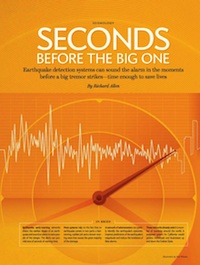| Home |
| Research |
| Downloads |
| Publications |
| Teaching |
| People |
| Press |
| Allen CV |
| Seismo Lab |
| Earth & Planetary |
| UC Berkeley |
|
Seconds before the big one
Richard M Allen Scientific American, April 2011. Download a reprint: AllenEEWScientificAmericanApr2011.pdf Earthquakes are unique in the pantheon of natural disasters in that they provide no warning at all before they strike. Consider the case of the Loma Prieta quake, which hit the San Francisco Bay Area on October 17, 1989, just as warm-ups were getting un- der way for the evening's World Series game between the San Francisco Giants and the Oakland A's. At 5:04 p.m., a sudden slip of the San Andreas Fault shook the region with enough force to collapse a 1.5-mile section of a double-decker freeway and sections of the Bay Bridge connecting Oakland with San Francisco. More than 60 people died. Over the years scientists have hunted for some signal-a pre- cursory sign, however faint-that would allow forecasters to pin- point exactly where and when the big ones will hit, something that would put people out of harm's way. After decades spent searching in vain, many seismologists now doubt whether such a signal even exists. Yet not all hope is lost. Within seconds of an earthquake's first subtle motions, scientists can now predict with some cer- tainty how strong and widespread the shaking will be. By inte- grating new science with modern communications technolo- gies, the authorities could get a few tens of seconds' warning, perhaps even half a minute, to those in harm's way. That may not sound like much, but it is enough to send shutdown warn- ings to power plants and rail networks, automatically open ele- vator doors and alert firefighters. |
|

